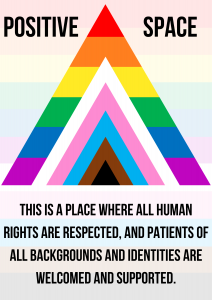Key Actions for More Inclusive Health Care
Inclusive Spaces
-

Photo by Zackary Drucker as part of Broadly’s Gender Spectrum Collection. CC-BY-NC-ND Offer universal washrooms
- Single occupancy universal washrooms help to increase accessibility for all patients so that everyone feels safe to use the washroom. This is especially important for trans and non-binary folks who may not feel comfortable or safe within traditional gendered washrooms.
- Post a sticker or poster indicating you are providing a safe and welcoming space, if your space is genuinely safe and accepting of diverse patients. If you have a website, be sure to include this information there as well.
- It is critical when displaying these signs of inclusion in your office space, that all individuals contribute and ensure the space remains safe and positive for all individuals.
- Represent diverse communities in your reading and informational materials.
- The value of being reflected and represented in everyday places is now well recognized. Ensure education or marketing materials include images of 2SLGBTQ+ people. Include a local 2SLGBTQ+ newspaper or a related national magazine such as OUT or The Advocate among your reading materials. Make the effort to create and/or provide educational materials with representation of folks who are often marginalized and underrepresented.
Staff Training
 Provide equity, diversity, and inclusion training for staff, including being able to recognize homophobia and transphobia in the office, and skills to successfully intervene.
Provide equity, diversity, and inclusion training for staff, including being able to recognize homophobia and transphobia in the office, and skills to successfully intervene.- Ensure these trainings are facilitated by members of the 2SLGBTQ+ community. Most cities have community organizations dedicated to this type of support, and may offer virtual training opportunities that help increase flexibility and accessibility (e.g., Trans Wellness Ontario)
- Safer Spaces is a Canadian organization that provides consultation, evaluation, self-guided training, and professional development workshops for individuals and workplaces, including health care providers.
Communication
- Be mindful to use the names, terms, and pronouns which the patient identifies
- Avoid ‘deadnaming‘ your patients.
- Take care to listen when a patient mentions the terms or pronouns they use for themselves (and their partners, if relevant).
- Ask the patient what language they would like to use when referring to their genitalia, reproductive organs, and other “primary sex characteristics” (e.g., “chest” might be preferred to “breasts”, or “genitals” instead of “penis”).
- Avoid making assumptions
- It is important to recognize that all individuals have multiple facets to them, and blanket labels never tell the whole story.
- Politely ask questions without judgment.
- When speaking of family planning, include options for adoption, surrogacy, insemination, etc.
- Recognize that there are various risks associated with different types of sex, and that sexual health is important for all individuals, regardless of if they have penetrative heterosexual sex or not. Be prepared to counsel your patients on STI protection for a variety of different types of sex.
- Recognize that individuals of varying genders may have internal and external genitalia that do not necessarily match their gender representation, and that there are some men who have vulvas or uteruses who need appropriate health care.
- Avoid challenging patients about their identity or sexual orientation
- The patient knows themselves best.
- While some questions might be necessary for assessment purposes related to sexual health, and reproductive or gender-affirming care, avoid unnecessary questions about and challenges to a patient’s identity.
- If a transgender woman comes to you concerned about her asthma, assess and treat the asthma; don’t unnecessarily trouble them with concerns about their identity or sexuality.
- Don’t make light of personal experiences
- Be mindful that, like everyone, past medical and personal experiences with the 2SLGBTQ+ community are complex. A comment that might seem benign in your experience is complicated in another person’s context.
General Care
-

Photo by Zackary Drucker as part of Broadly’s Gender Spectrum Collection. CC-BY-NC-ND Treat the patient as an individual, recognizing each experience is unique and valid.
- Take the time to learn about 2SLGBTQ+ resources and services; and connect with 2SLGBTQ+ groups in the community to increase your knowledge and understanding.
- Being knowledgeable about resources increases patients’ comfort and confidence in the physician-patient relationship.
- Provide inclusive forms and use inclusive charts/records when possible.
- Some areas for inclusion might be: family status information (beyond the typical marital status); pronouns; chosen name if different from health card or legal documents; multiple options or an open-format for gender and/or sexual identity
Media Attributions
- Two students in a gender neutral bathroom. © Zackary Drucker is licensed under a CC BY-NC-ND (Attribution NonCommercial NoDerivatives) license
- Positive Space Poster © Ashlyne O'Neil is licensed under a CC BY-NC-SA (Attribution NonCommercial ShareAlike) license
- A transgender woman in a hospital gown being treated by a trans doctor © Zackary Drucker is licensed under a CC BY-NC-ND (Attribution NonCommercial NoDerivatives) license
definition
(verb)
refers to when someone refers to a person by the name they used before their transition. This is often invalidating and can cause someone to feel like you do not respect their identity, that you do not support their transition, or that you are unwilling to put in the effort to make this necessary change.

